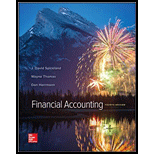
Identify the value at which the cost of the asset would be recorded.
Answer to Problem 1SSQ
b. Cost of the asset plus all costs necessary to get the asset ready for use.
Explanation of Solution
Long term Assets: Long term assets are assets that can be held for a longer period of time and cannot be easily converted to cash. They are also known as non-current assets. The long term asset includes the property, plant and equipment, long term investments and intangible assets.
Explanation for the incorrect answer:
a. Cost of the asset only. Long term assets are initially recorded at its cost plus all the expenditures that are necessary to get the asset ready for use. Thus, the long term assets are not recorded at the cost of the asset. Hence, this is incorrect option.
c. Appraised value. Appraised value is an assessment of a property’s value based on a given point of time and thus, appraised value is not recorded as the cost of the asset. Hence, this is incorrect option.
d. Cost of the asset, but subsequently adjust it up or down to appraised value. Long term assets are recorded at its cost plus all the expenditures that are necessary to get the asset ready for use. Hence, this is incorrect option.
Explanation for the correct answer:
b. Cost of the asset plus all costs necessary to get the asset ready for use. Long-term assets are initially recorded at its cost plus all the expenditures that are necessary to get the asset ready for use. The initial cost of the Long term asset might be more than the purchase price. The long term assets also include additional amounts which are paid by the firm, to bring the asset to its desired condition and location for use. Hence, this is correct option.
Hence, the correct option is b. Cost of the asset plus all costs necessary to get the asset ready for use.
Want to see more full solutions like this?
Chapter 7 Solutions
Financial Accounting (Connect NOT Included)
- I am searching for the accurate solution to this financial accounting problem with the right approach.arrow_forwardI am looking for the correct answer to this general accounting problem using valid accounting standards.arrow_forwardPlease given correct answer for General accounting question I need step by step explanationarrow_forward
- Chalmers Corporation operates in multiple areas of the globe, and relatively large price changes are common. Presently, the company sells 110,200 units for $50 per unit. The variable production costs are $20, and fixed costs amount to $2,079,500. Production engineers have advised management that they expect unit labor costs to rise by 10 percent and unit materials costs to rise by 15 percent in the coming year. Of the $20 variable costs, 25 percent are from labor and 50 percent are from materials. Variable overhead costs are expected to increase by 20 percent. Sales prices cannot increase more than 12 percent. It is also expected that fixed costs will rise by 10 percent as a result of increased taxes and other miscellaneous fixed charges. The company wishes to maintain the same level of profit in real dollar terms. It is expected that to accomplish this objective, profits must increase by 8 percent during the year. Required: Compute the volume in units and the dollar sales level…arrow_forwardAfter describing a threat/risk in either the revenue cycle (i.e., in sales and cash collection activities) or the expenditure cycle (i.e., in purchases or cash disbursement activities). What are specific internal controls that might be applied to mitigate each of the threats we've identified?arrow_forwardCompare and contrast the procedures for lodging an objection in Jamaica with those of Trinidad and Tobago.arrow_forward
- The actual cost of direct labor per hour is $16.25 and the standard cost of direct labor per hour is $15.00. The direct labor hours allowed per finished unit is 0.60 hours. During the current period, 4,500 units of finished goods were produced using 2,900 direct labor hours. How much is the direct labor rate variance? A. $3,625 favorable B. $3,625 unfavorable C. $4,350 favorable D. $4,350 unfavorablearrow_forwardOn January 1 of the current year, Piper Company issues a 4-year, non-interest-bearing note with a face value of $8,000 and receives $4,952 in exchange. The recording of the issuance of the note includes a: a. credit to Notes Payable for $4,952. b. credit to Discount on Notes Payable for $3,048. c. debit to Discount on Notes Payable for $3,048. d. debit to Cash for $8,000.arrow_forwardPLease helparrow_forward

 AccountingAccountingISBN:9781337272094Author:WARREN, Carl S., Reeve, James M., Duchac, Jonathan E.Publisher:Cengage Learning,
AccountingAccountingISBN:9781337272094Author:WARREN, Carl S., Reeve, James M., Duchac, Jonathan E.Publisher:Cengage Learning, Accounting Information SystemsAccountingISBN:9781337619202Author:Hall, James A.Publisher:Cengage Learning,
Accounting Information SystemsAccountingISBN:9781337619202Author:Hall, James A.Publisher:Cengage Learning, Horngren's Cost Accounting: A Managerial Emphasis...AccountingISBN:9780134475585Author:Srikant M. Datar, Madhav V. RajanPublisher:PEARSON
Horngren's Cost Accounting: A Managerial Emphasis...AccountingISBN:9780134475585Author:Srikant M. Datar, Madhav V. RajanPublisher:PEARSON Intermediate AccountingAccountingISBN:9781259722660Author:J. David Spiceland, Mark W. Nelson, Wayne M ThomasPublisher:McGraw-Hill Education
Intermediate AccountingAccountingISBN:9781259722660Author:J. David Spiceland, Mark W. Nelson, Wayne M ThomasPublisher:McGraw-Hill Education Financial and Managerial AccountingAccountingISBN:9781259726705Author:John J Wild, Ken W. Shaw, Barbara Chiappetta Fundamental Accounting PrinciplesPublisher:McGraw-Hill Education
Financial and Managerial AccountingAccountingISBN:9781259726705Author:John J Wild, Ken W. Shaw, Barbara Chiappetta Fundamental Accounting PrinciplesPublisher:McGraw-Hill Education





